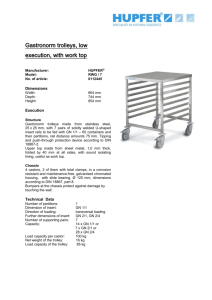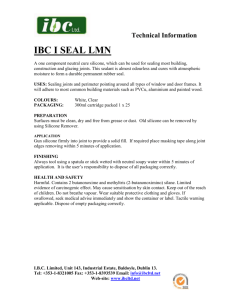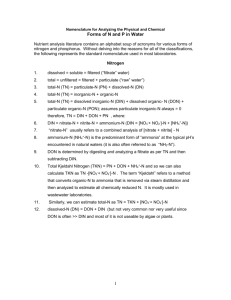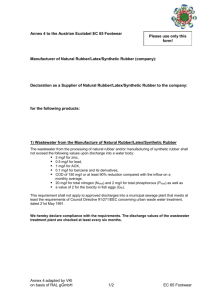Criteria For Evaluating Transfer Pricing Methods
advertisement
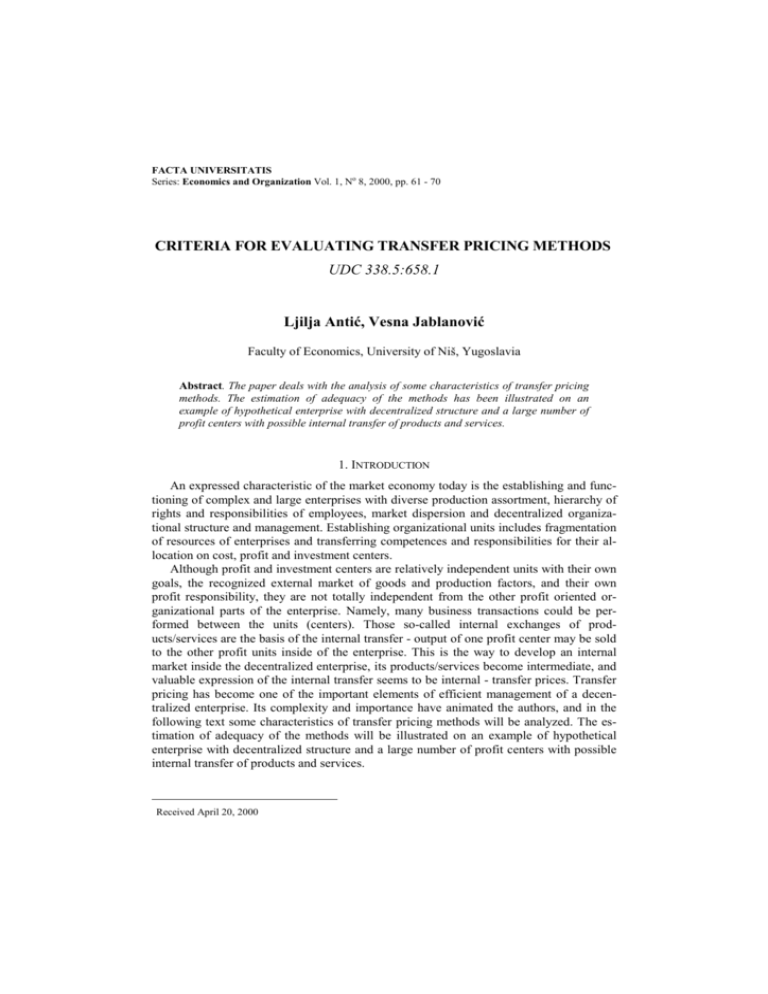
FACTA UNIVERSITATIS Series: Economics and Organization Vol. 1, No 8, 2000, pp. 61 - 70 CRITERIA FOR EVALUATING TRANSFER PRICING METHODS UDC 338.5:658.1 Ljilja Antić, Vesna Jablanović Faculty of Economics, University of Niš, Yugoslavia Abstract. The paper deals with the analysis of some characteristics of transfer pricing methods. The estimation of adequacy of the methods has been illustrated on an example of hypothetical enterprise with decentralized structure and a large number of profit centers with possible internal transfer of products and services. 1. INTRODUCTION An expressed characteristic of the market economy today is the establishing and functioning of complex and large enterprises with diverse production assortment, hierarchy of rights and responsibilities of employees, market dispersion and decentralized organizational structure and management. Establishing organizational units includes fragmentation of resources of enterprises and transferring competences and responsibilities for their allocation on cost, profit and investment centers. Although profit and investment centers are relatively independent units with their own goals, the recognized external market of goods and production factors, and their own profit responsibility, they are not totally independent from the other profit oriented organizational parts of the enterprise. Namely, many business transactions could be performed between the units (centers). Those so-called internal exchanges of products/services are the basis of the internal transfer - output of one profit center may be sold to the other profit units inside of the enterprise. This is the way to develop an internal market inside the decentralized enterprise, its products/services become intermediate, and valuable expression of the internal transfer seems to be internal - transfer prices. Transfer pricing has become one of the important elements of efficient management of a decentralized enterprise. Its complexity and importance have animated the authors, and in the following text some characteristics of transfer pricing methods will be analyzed. The estimation of adequacy of the methods will be illustrated on an example of hypothetical enterprise with decentralized structure and a large number of profit centers with possible internal transfer of products and services. Received April 20, 2000 62 LJ. ANTIĆ, V. JABLANOVIĆ 2. METHODS AND CRITERIA OF TRANSFER PRICING Many enterprises today have a decentralized structure with some variation of vertical integration in which the result of one unit (center) becomes the input of another unit [1]. Transfer price is the financial basis used to quantify the transfer of products and services from one unit to another [5, p. 1075]. It enables to determine if the participation of each participant (unit) in the internal transfer is adequate and correct, as well as to measure its efficiency. Transfer pricing has become a very influential factor of efficient management [6, p. 26] and one of the most important elements in performance measurement of decentralized enterprise and its parts. The internal transfer of products or services can impact positively or negatively the performance measures used for organizational units (centers) just the same as the external transfer of products and services. It should be obvious that a conflict is likely to arise in an enterprise between its center managers because the "buyer" center wants the transfer price to be as low as possible while the "seller" center wants the transfer price to be as high as possible. Therefore, when an exchange of products or services takes place between a center and an external party, the forces of demand and supply on market determine the price in external transactions. An exchange of products or services between a center and an internal party, however, poses a potentially more serious and complex problem than the external exchange. What transfer price should be set so that buying and selling centers, acting in their own best interests, will at the same time act in the best interests of the enterprise as a whole? [5, p. 1076] This is a serious question because sub optimal decision making will result if either (1) the buying center manager goes to an external supplier to satisfy his needs when he should have gone to the selling center manager or (2) the buying center manager goes to the selling center manager to satisfy his needs when he should have gone to an external supplier. Consequently, upper-level management may insist that the buying and selling centers, although they are theoretically autonomous units, always take only those actions that are in the best interests of the enterprise as a whole, which may result in undesirable behavior of centers and their managers and pseudodecentralization. The solution of the problem of inadequate decision-making on different managerial levels in the enterprise could be a reliable information basis for transfer prices, as they should be the significant informational input for managers on all levels and express real performance of each center [4, p. 102]. There are several different methods for determining transfer prices [3, 5]. The basic methods are cost-based transfer pricing, cost-plus transfer pricing (full costs plus normal markup), negotiated transfer pricing (results of negotiations between buying and selling centers) and market-based transfer pricing (if there is an external market price for intermediate products or services). Also, there are certain alternative methods, such as synthetic market pricing (incorporating opportunity cost to the enterprise as a whole), and dual transfer pricing system. The transfer pricing method used must be the one most beneficial to the enterprise. The following four interrelated criteria should be used to evaluate adequacy of the transfer pricing methods that are currently being used by profit or investment centers [5, p. 1077]: 1. Goal congruence. The transfer prices that are set should enable a harmonization of goals of enterprise as a whole and its parties (centers) as well as to avoid sub optimal decision-making. Criteria for Evaluating Transfer Pricing Methods 63 2. Motivation. Transfer prices should not interfere with the process wherein the buying center manager rationally strives to minimize his costs and the selling center manager rationally strives to maximize his revenues. 3. Autonomy. Each center manager should be free to satisfy his own needs either internally or externally at the best possible price. This also means a higher autonomy of profit or investment centers in the enterprise. 4. Performance evaluation. Transfer prices should enable objective evaluation of profit center results giving the information for optimal decision-making and real appraisal of managerial performance and economic value of particular parties of the enterprise. In accordance with the criteria, the transfer pricing method should be chosen in the way to be the most beneficial for the enterprise as a whole as well as for its organizational parties. Frequently, the choice of the method is connected with the motivation and autonomy of profit (or investment) center managers and their maximum coordination. Each of the various transfer pricing methods currently in use will be discussed only in relation to profit centers for two reasons: First, transfer prices impact on profit and investment centers in an identical manner; and second, the analysis will be more efficient and comprehensive by being restricted to a single type of responsibility center. 3. ILLUSTRATION OF TRANSFER PRICING METHODS The problems of transfer pricing will be illustrated on an example of hypothetical enterprise "Light" with a large number of profit centers, including A (representing the selling profit center) and B (representing the buying profit center). Profit center B manufactures and sells the product Y with selling price of 26 din. per unit. Profit center B needs 10.000 units of component 9, which is an integral part of product Y. Component 9 can either be purchased by external supplier for 21 din. per unit or internally by profit center A. In addition to component 9, profit center A regularly manufactures between 20.000 and 30.000 units of component 10 which is sold at a 60% markup on full cost, that is at 24,32 din. per unit (15,20 din. x 160%). Component 10 is slightly different from component 9 because of the use of more costly direct materials; so it cannot be substituted for component 9 in the manufacture of product Y. The standard and actual controllable costs of profit centers A and B for production and sale of components 9 and 10 and product Y is given in the Table 1. Table 1. Elements Cost of direct materials Cost of direct labor Variable factory overhead Fixed factory overhead Variable selling costs Fixed selling costs Transfer price Total controllable costs Profit center A Component 9 2,40 2,00 4,50 1,50 2,60 0,60 − 13,60 Unit costs (in din.) Profit center A Component 10 4,00 2,00 4,50 1,50 2,60 0,60 − 15,20 Profit center B Product Y 0,60 1,00 1,60 0,50 0,30 0,20 ? ? 64 LJ. ANTIĆ, V. JABLANOVIĆ Each of the transfer pricing methods in current use will be discussed from the perspective of the buying profit center, the selling profit center, the enterprise as a whole, and the four interrelated criteria. 3.1. Cost-based transfer pricing Cost-based transfer pricing is the simplest transfer pricing method. It assumes using standard costs as a basis of pricing on the way that does load neither buying profit center nor selling profit center in exchanging intermediate product/service. The method of "full product costs" include all production costs as well as costs from other business functions and it could be applied for intermediate products with specific characteristics that cannot be found on the external market. For the illustration of the cost-based transfer pricing, two cases will be analyzed. In the first illustration, the transfer price for component 9 will be set equal to variable costs, that is 11,50 din. per unit (2,40 din. +2,00 din. +4,50 din. +2,60 din.). The relevant incomes for profit center B and the enterprise as a whole are shown in the Table 2. Table 2. Elements 1. Market price of product Y 2. Relevant costs 2.1. Variable costs of profit center B 2.2. Transfer price of profit center A 3. Relevant income Profit center B (Internal transfer) 26,00 15,00 3,50 11,50 11,00 Enterprise (Internal transfer) 26,00 15,00 3,50 11,50 11,00 A transfer price set equal to variable costs will lead to goal congruence. That is, the 11,50 din. per unit transfer price "sends a signal" to profit center B to buy 10.000 units of component 9 from profit center A instead of from the external supplier at 21 din. per unit. Both profit center B and the enterprise as a whole will have relevant income of 11,00 din. per unit if the internal transfer takes place. Unfortunately, the motivation and performance evaluation criteria are violated from the viewpoint of profit center A. Namely, profit center A will not be motivated to sell component 9 internally, at a transfer price of 11,50 din. per unit, since it fails to cover at least the full costs of 13,60 din. that would result in a long-run loss. If profit center A objects to making the transfer but is forced to do so by upper-level management, then the autonomy criterion would not be satisfied. In the second illustration, the transfer price for component 9 will be set equal to full costs, that is 13,60 din. per unit. The relevant incomes for profit center B and the enterprise as a whole are shown in the Table 3. Table 3. Elements 1. Market price of product Y 2. Relevant costs 2.1. Variable costs of profit center B 2.2. Transfer price of profit center A 3. Relevant income Profit center B (Internal transfer) 26,00 17,10 3,50 13,60 8,90 Enterprise (Internal transfer) 26,00 15,00 3,50 11,50 14,50 Criteria for Evaluating Transfer Pricing Methods 65 A transfer price set equal to full costs will still lead to goal congruence. Profit center B "will be sent a signal" to buy 10.000 units of component 9 from profit center A at 13,60 din. per unit, because it is lower than the price of external supplier (21 din.). With per unit relevant incomes of 8,90 din. and 14,50 din. profit center B and the enterprise as a whole will benefit from the internal transfer. Once again, profit center A does not realize a profit at a transfer price of 13,60 din. per unit. As a consequence, the criteria of motivation and performance evaluation are still not satisfied. The autonomy criterion would also pose a problem if upper-level management enforced a transfer, assuming profit center A was unwilling to do so. A cost-plus transfer price is often used to overcome the motivation and performance evaluation problems associated with transfer prices set equal to either variable cost or full cost. "The cost-plus method is used as an approximation of market price and it is considered as a practical approach to the problem of divergent profit center and corporate interests" [5, p. 1080]. The basic costs used in determining the transfer prices based on the cost-plus method could be variable or the full costs. Even though the transfer price set by this method will be higher than full cost, it may still be in the best interests of the buying profit center and the enterprise as a whole to transfer the product within the enterprise. In the illustration of the cost-plus method, the transfer price of component 9 will be set equal to full cost (13,60 din. per unit) plus normal markup (60%) so that the transfer price equals 21,76 din. per unit (160%×13,60 din.). In this case, profit center B "will be sent the signal" to buy 10.000 units of component 9 from the external supplier at 21 din. per unit, because it would be less than the transfer price of 21,76 din. per unit. The relevant income of profit center B in this case is 1,50 din. per unit, the difference between the market price of product Y of 26 din. and relevant costs of 24,50 din. (Sum of the variable cost of profit center B of 3,50 din. and the external price of 21 din.). However, as a result, the enterprise as a whole will be "penalized" 9,50 din. per unit, the difference between the external price of 21 din. and the relevant variable costs of 11,50 din. per unit to make and sell component 9 in profit center A. The transfer price set equal to full cost plus markup will not lead to goal congruence, but with respect to the three remaining criteria motivation, autonomy, and performance evaluation - this transfer price leads to their satisfaction from the perspective of both the buying and the selling profit center. 3.2. Negotiated transfer pricing A negotiated price is set by negotiations between buying and selling profit centers [2, p. 275]. In certain cases, the units of an enterprise are free to negotiate the transfer price between them. Assuming that the two profit center managers (A and B) negotiate a transfer price equal to full cost (13,60 din. per unit) plus half the normal markup (30%), so that the transfer price equals 17,68 din. per unit (130%×13,60 din.), the relevant incomes for profit center B and the enterprise as a whole are (Table 4): 66 LJ. ANTIĆ, V. JABLANOVIĆ Table 4. Elements 1. Market price of product Y 2. Relevant costs 2.1. Variable costs of profit center B 2.2. Transfer price of profit center A 3. Relevant income Profit center B (Internal transfer) 26,00 21,18 3,50 17,68 4,82 Enterprise (Internal transfer) 26,00 15,00 3,50 11,50 11,00 The negotiated transfer price satisfies all four criteria. It covers the full costs and makes a profit for profit center A. At the same time, it is lower than the external price, so profit centers A and B is motivated for the internal transfer, and the criteria of goal congruence, performance evaluation and autonomy are not endangered. However, one of the serious difficulties with this method is that it takes time and a great deal of analysis and data. Also, possible overemphasis on profit center interests rather than enterprise interests may result in negotiated transfer pricing. 3.3. Market-based transfer pricing Where a competitive market price exists for the output of a profit center, such as the price charged to external customers, the market price is thought to be the most objective measure of the economic value of the product or service being internally transferred. The internal transfer will be made where component 9 (in the example) is equal to component of the external seller in quality and price. The relevant incomes for profit center B and the enterprise are shown in the Table 5. Table 5. Elements 1. Market price of product Y 2. Relevant costs 2.1. Variable costs of profit center B 2.2. Transfer price of profit center A 3. Relevant income Profit center B (Internal transfer) 26,00 24,50 3,50 21,00 1,50 Enterprise (Internal transfer) 26,00 15,00 3,50 11,50* 11,00 (*Variable costs of producing and selling component 9: 11,50 = 2,40 + 2,00 + 4,50 + 2,60) The use of the external (outside) market price appears on the surface to be an ideal transfer price in that it leads to goal congruence, motivation, autonomy, and performance evaluation. However, there are situations illustrated below, where this approach will lead to sub optimal decision-making, particularly violating the goal congruence criterion. In situation 1 it is assumed that profit center A does not have any idle capacity to accommodate profit center B'needs for 10.000 units of component 9. The relevant incomes for profit center B and the enterprise as a whole are shown in the Table 6. Criteria for Evaluating Transfer Pricing Methods 67 Table 6. Elements 1. Market price of product Y 2. Relevant costs 2.1. Variable costs of profit center B 2.2. Opportunity cost of profit center A 2.3. Transfer price of profit center A 3. Relevant income Profit center B (Internal transfer) 26,00 24,50 3,50 − 21,00 1,50 Enterprise (Internal transfer) 26,00 26,22 3,50 11,22* 11,50 (0,22) * Computation of opportunity cost of profit center A: Market price of component 10 Relevant costs: Production Selling Relevant income 24,32 din. 13,10 din. 10,50 din. 2,60 din. 11,22 din. The 21,00 din. per unit transfer price "signals" profit center B to buy inside, since component 9 cannot be purchased any cheaper on the external market. This decision will be in the best interests of profit center B, whose income will increase 1,50 din. per unit. However, this decision is not good for the enterprise as a whole, because it would lose 0,22 din. per unit. In situation 2 it is assumed that profit center A has sufficient idle capacity to accommodate the needs of profit center B for 10.000 units of component 9. However, now there is the possibility of a reciprocal trading agreement between an external supplier and profit center C, which is inside the enterprise. Namely, the external supplier will acquire 15.000 units of subcomponent 100 from profit center C, only if profit center B purchases 10.000 units of component 9 from it. The market price of component 100 is 14 dins. per unit. Production and selling of component 100 require 2,00 din. per unit of variable costs. The relevant incomes of profit center B and the enterprise as a whole are shown in the Table 7. Table 7. Elements 1. Market price of product Y 2. Relevant costs 2.1. Variable costs of profit center B 2.2. Opportunity cost of profit center C 2.3. Transfer price of profit center A 3. Relevant income Profit center B (Internal transfer) 26,00 24,50 3,50 − 21,00 1,50 Enterprise (Internal transfer) 26,00 27,00 3,50 12,00* 11,50 (1,00) * Computation of opportunity cost of profit center C: Market price of subcomponent 100 Relevant costs: Variable costs of production and selling Relevant income 14,00 din. 2,00 din. 2,00 din. 12,00 din. 68 LJ. ANTIĆ, V. JABLANOVIĆ Since the external market price is not lower than the transfer price, profit center B will buy component 9 from profit center A. This decision benefits profit center B to the extent of 1,50 din. per unit, but is disadvantageous to the enterprise as a whole to the extent of 1,00 din. per unit. If upper-level management interferes in order to achieve goal congruence, there will be a violation of the autonomy criterion. 3.4. Transfer pricing by the method of synthetic market price In case of the possible absence of an internal market and the failure of the external market price with regard to the situations 1 and 2, a synthetic market price will be introduced [5, p. 1084]. The synthetic market price is computed as follows: Synthetic market = price Variable costs of the selling profit center + Opportunity cost to the enterprise as a whole where opportunity costs are defined as the maximum contribution forgone by the enterprise missing the best supply on the external market [3, p. 875]. The synthetic market price will always "send" the proper signals to the buying profit center, so it is often marked as the "ideal transfer price" or the "optimum transfer price" [5, p. 1084]. It determines the transfer price, which enables optimal decision-making from the standpoint of the enterprise as a whole in the different specific situations. In order to evaluate the synthetic market price against the four criteria, the following three tests should be administered [5, p. 1084]: In the first test, return to situation 1 profit center A does not have any idle capacity to accommodate the needs of profit center B for 10.000 units of component 9 - and reset the transfer price equal to the following synthetic market price: Synthetic market price = 11,50 din. + 11,22 din. = 22,72 din. The 22,72 din. per unit transfer price "signals" profit center B to buy the 10.000 units of component 9 from the external supplier at 21,00 din. per unit. This decision will be in the best interest of profit center B, whose income will increase by 1,50 din. per unit. The decision also will be in the best interest of the enterprise as a whole that will avoid losing the 0,22 din. per unit, and the other criteria will be satisfied as well, especially the autonomy criterion. In the second test, return to situation 2 - a reciprocal trading agreement exists between the external supplier and profit center C - and resets the transfer price equal to the following synthetic market price: Synthetic market price = 11,50 din. + 12,00 din. = 23,50 din. The 23,50 din. per unit transfer price "sends" a signal to profit center B to buy 10.000 units of component 9 from the external supplier at 21,00 din. per unit and increase the income to the extent of 1,50 din. per unit. The enterprise as a whole will not be disadvantaged to the extent of 1,00 din. per unit, and the four criteria will be satisfied. In the third test - transfer price equal to market price - the transfer price will be equal to the following synthetic market price: Synthetic market price = 11,50 din. + 0 din. = 11,50 din. Criteria for Evaluating Transfer Pricing Methods 69 A transfer price of 11,50 din. per unit goes back to the situation wherein the transfer price was set equal to the variable cost of component 9 (2,40 din. + 2,00 din. + 4,50 din. + 2,60 din.). There the 11,50 din. per unit transfer price "signaled" profit center B to buy the 10.000 units of component 9 from profit center A, as opposed to the external supplier at 21,00 din. per unit. The goal congruence criterion is satisfied, because both profit center B and the enterprise as a whole benefit by 11 din. per unit (the market price of product Y at 26 din. reduced for the sum of 3,50 din. per unit variable costs of profit center B and the transfer price of profit center A equal to the 11,50 din. per unit variable costs of component 9). The synthetic market price, however, fails to satisfy the motivation, autonomy and performance evaluation criteria for profit center A. Namely, profit center A will not be motivated to sell component 9 internally, at a transfer price of 11,50 din. per unit, since it fails to cover at least the full costs of 13,60 din. that would result in a long-run loss. If profit center A objects to making the transfer but is forced to do so by upper-level management, then the autonomy criterion would not be satisfied. The synthetic market price provides a correct basis for making decision about optimal scope of activities and for control, that is for real profit center performance measurement [4, p. 116]. Therefore, it is an adequate conceptual model for different situations of optimal transfer pricing. In conclusion, the synthetic market price will always lead to goal congruence but may lead to motivation and performance evaluation problems for selling profit center. The latter problem can be easily remedied through the use of a dual transfer pricing system. 3.5. Dual transfer pricing system The buying profit center and the selling profit center have different interests in the transfer price. In one case, the price is used to make a decision to buy and thereby determine the output of the buying profit center; and in the other case, the price is an important factor in evaluating the performance of the selling profit center [5, p. 1085]. Namely, there is seldom a single transfer price that simultaneously meets the criteria of goal congruence, autonomy, motivation and performance evaluation. Therefore, some enterprises turn to dual pricing, using two separate transfers pricing methods to price each buying and selling transaction inside the internal exchange. A frequent example of dual pricing arises when the selling profit center receives a cost (full or variable) plus "normal" markup-based transfer price and the buying profit center pays the synthetic market price for the internally transferred product/services. The dual pricing method leads to goal congruence both of the buying profit center (it buys at a lower price than the external market price) and the selling profit center (being subsidized by the enterprise) [3, p. 874]. The dual transfer pricing method is based on the logic of linear programming [6, p. 53], that is on the relation between primary and dual solution of a linear programming problem. Namely, each solution of maximizing is related to a solution of minimizing and this method of linear programming is completely adequate in searching for optimal allocation of resources (primary problem), on the one hand, and searching for optimal internal pricing system (dual problem). That relation makes the dual prices as an adequate measure of opportunity costs in efficient internal transferring product/services. However, the practical use of linear programming in transfer pricing is "the modest" related to the other methods. Nevertheless, there are some situations when an optimal solution can be 70 LJ. ANTIĆ, V. JABLANOVIĆ found only by using the method of linear programming, especially in the conditions of complex interdependence between profit centers, which have limited resources and produce several intermediate products usable both internally and externally. The primary solution of the problem gives an optimal production program with maximal marginal revenue from the limited resources. The solution of dual problem is a "byproduct" of solving the problem of allocation of resources, which is reflected in transfer pricing by the method of linear programming. Dual pricing is not widely used in practice even though it satisfies the four criteria of transfer pricing methods in different situations. The reasons are numerous: insufficient incentives of the selling profit center manager to control its costs with a dual-price system; insufficient information for the profit center managers about the level of decentralization that the top management seeks; an insulation of the profit center managers from the frictions of both external and internal market [3, p. 875]. A solution could be in the possibility to set several different dual prices for each product on different conditions and limitations, so that each profit center would have the information about the transfer prices in different business conditions. Certainly, it should search for the way of introducing linear programming techniques in solving the problems of valuating the internal transfers in decentralized enterprises. REFERENCES 1. Bricley, J., Smith, W. and Zimmerman, J., Managerial Economics and Organizational Architecture, Irwin, Inc. Company, 1997. 2. Edlin, S. A. and Reichelstein, S., Specific Investment Under Negotiated Transfer Pricing: An Efficiency Result, The Accounting Review, Vol. 70, No. 2, 1995, pp. 275-291. 3. Horngren, Ch., Foster, G. and Datar, S., Cost Accounting - A Managerial Emphasis, Prentice-Hall, New York, 1994. 4. Malinić, D., Divizionalno računovodstvo, Ekonomski fakultet, Beograd, 1997. 5. Polimeni, R., Fabozzi, F. and Adelberg, A., Cost Accounting, McGraw-Hill, Inc., New York, 1991. 6. Singer-Kosanović, V., Interne cijene u poslovnom sistemu, Informator, Zagreb, 1976. KRITERIJUMI ZA OCENU METODA FORMIRANJA TRANSFERNIH CENA Ljilja Antić, Vesna Jablanović U radu se analiziraju neke karakteristike metoda formiranja transfernih cena. Ocena adekvatnosti pojedinih metoda ilustrovana je na primeru hipotetičkog preduzeća sa decentralizovanom strukturom i velikim brojem profitnih centara sa mogućim transferisanjem intermedijarnih proizvoda i usluga izmedju njih.
